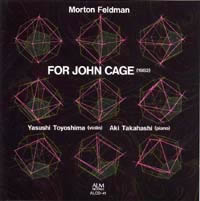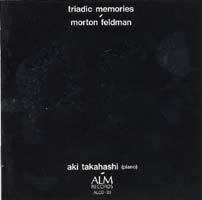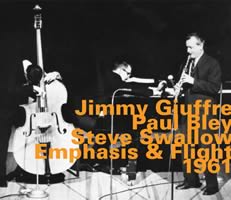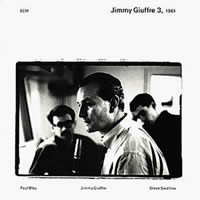Random Noise 6: Super OTW Lives!
|
[With our usual thanks to OnSoundandMusic.com for permission to post these Random Noise columns in La Folia. M.S.] Mike Silverton [February 2004.] Back when hi-fi’s included AM-FM tuners, I would listen now and again to a New-York-area DJ who played music of the Baroque, for the most part Italian. He was a prissy little guy (I’m guessing at his stature) and fast to take offense, as I also recall from his on-air tirades. Anyway, he would describe the recordings he was about to play as OTW or super OTW. OTW: out of this world. Couldn’t be bothered with anything less. As a memorial to my misspent youth, let’s hear a rousing Super OTW! for the discs I herein describe.
En route (I hope) are several ALM CDs I requested for review, music of a living Japanese composer, Jo Kondo. To remind myself of the label’s extraordinary quality, I played a favorite recording, Morton Feldman’s For John Cage, ALM ALCD-41, a two-disc set recorded in 1991 and released two years later. The violin and piano soloists are Yasushi Toyoshima and Aki Takahashi. Feldman was a great admirer of Aki Takahashi’s musicianship. (She is the sister of the likewise noteworthy Yuji Takahashi.) Indeed, the insert to an earlier release, ALCD-33, Triadic Memories, a work for piano alone, includes Feldman’s talk about the then soloists who had taken it on: the late David Tudor, Roger Woodward, and Aki Takahashi. (Feldman delivered his remarks to an audience in Buffalo, New York, as a preliminary to Takahashi’s performance.) The composer is diplomatic but it’s clear that he’s much the more taken with Takahashi’s rather amazingly poetic interpretation. Yukio Kojima recorded this ALM release in 1983 in Japan. It is certainly among the most beautiful discs in my collection, as is the For John Cage set. Kojima is a brilliant recording engineer. ALM is distributed in the US by OODiscs (http://www.oodiscs.com/). Feldman (1926-1987) is one of my favorite modernist composers. As to modernist, an unwritten law obtains: If you wish to be counted among the culture’s avant-garde, it is your duty to discomfit middlebrows. Accommodate this crowd and your days at the front are finished and gone. Épater le bourgeois or else. A paradox: In Aki Takahashi’s reading of Triadic Memories especially, we encounter Feldman as a sensual colorist. The same is true of For John Cage. No one writing music comes closer to synaesthesia. As a rule, your card-carrying avant-gardiste is suspicious of beauty. Disdains the stuff. It’s not what he’s after. Whatever it is he lives for, it certainly isn’t to please. But Feldman’s credentials are in no way threatened. He épaters le bourgeois by way of duration, e.g., a five-hour string quartet, into which he packs a sandwich-bag’s worth of incident. Toyoshima and Takahashi perform For John Cage in just under 100 minutes without breaking a sweat. Muscle cramps, most likely. And yet, for all its anorexia and numbing sameness, the music is beautiful, remarkably so. And just disturbing enough to avoid conflation with New-Age therapeutics. As I hear it, these two ALM Feldman releases traffic in perfection, performance and recording. Feldman’s fascination dwells as much in overtones and lengthy decays as in the writing’s provocative simplicity. Time is a friend that brackets an atmosphere these recordings capture to the last radiant molecule. I know of no better view of Feldman’s (literally) inimitable art. ***
Like clockwork, another choice hatART: a two-CD set entitled Jimmy Giuffre, Paul Bley, Steve Swallow / Emphasis & Flight 1961, hatOLOGY 2-595. South-German Radio recorded Emphasis in Stuttgart on November 7th; Radio Bremen recorded Flight on November 23, 1961, both live, with applause. (The Bremen set first appeared on CD in 1992 as hatART Jazz Series 6071, the Stuttgart as 6072.) While Art Lange’s notes provide an illuminating background, words however apt cannot prepare the listener for the trio’s impeccable quality. In jazz especially, music on recording often shows its age, which is to say, reveals itself as of its era: swing, bebop, cool, free . Not so with Emphasis and Flight. These numbers sound as fresh as tomorrow as well as beyond category. Timelessness, vintage 1961, is today a lovely thing to contemplate. However, cognoscenti and fans then notwithstanding, the trio’s work fell on unacclimated ears. Like other sensitive souls whose art raised objections or met with indifference, Giuffre, Lange writes, retreated into teaching, although to be sure, he did not become completely reclusive with respect to performing. Nevertheless, Giuffre’s apogee as an innovator-performer encircles the time of these sets. As with everything, history informs art. Both Emphasis and Flight participate in Modernism’s most enduring moments. Giuffre’s adaptations of classical’s avant-garde render the music available to any manner of critical measure. I’ve heard classical-influenced jazz sounding like Stravinsky’s L’Histoire du soldat with dentures. To their everlasting credit, Giuffre, Bley and Swallow deal in substance, not borrowed styles. One needn’t be a musicologist to detect a seamless employment of sophisticated usages bearing no clear resemblance to anyone else’s work. Interplay and ensemble equal to the best of its time, category notwithstanding, and yet loose-limbed enough to sound like jazz. (As to what authenticates jazz, in 1961, fans, steeped in cliché, judged a small, drummerless ensemble unseemly. This reminds me of those tango fanatics who would have liked to see Astor Piazzolla dead for the liberties he took with their beloved dance.) For all its novel and remarkably comfortable complexity, perhaps Giuffre’s vision never achieved the stature it deserved because of its unremittingly civilized demeanor. We tend to think of the revolutionary in jazz in terms of the intrusive, and Giuffre’s trio’s work is anything but. The boys weren’t hammering hard enough. Were I exiled to that proverbial desert island (with electricity, please) and limited to a hand’s-span of jazz CDs, this set would be among them. “Mix, CEDAR processing and CD master by Peter Pfister, January 2003.” The excellent Pfister permits us to see just how fine these analog originals are. You can mix and process to your heart’s content, a sow’s ear’s a sow’s ear. These two German-radio productions are elegant silk purses. *** [Walt Mundkowsky adds these thoughts and information:]
[JIMMY GIUFFRE 3: 1961 (Fusion and Thesis). Giuffre, clarinet; Paul Bley, piano; Steve Swallow, bass. ECM 1438/39 422849 644-2 (2 CDs, available since 1992). By the mid-Fifties Jimmy Giuffre — a lyrical clarinet and tenor sax player — had tired of the restrictions a conventional rhythm section imposed. His early drummerless trios produced an astringent pastoralism of great charm. This 1961-62 incarnation was also deaf to the bebop and free-form fashions of the day, but on an altogether more searching and profound level. It made three studio albums before dissolving, the first two of which are collected here. If much of that era’s experimentation hasn’t worn well, Fusion and Thesis sound as exhilarating, lucid and unfettered as ever. (Free Fall, their more radical third effort, hit CD in 1998 as Columbia / Legacy CK 65446.) The quiet dynamics, the independence of lines and timbres, the crucial silences — these might describe the chamber works of Anton Webern, not jazz. But the music is almost entirely improvised (hard to believe, given its complexity and finish), and it definitely swings in its own manner, alert and intense. On first exposure Thesis seems the more tightly argued and Fusion the more soulful, but it’s mostly due to differences in the original materials. Both offer singular experiences. All praise, then, to ECM founder Manfred Eicher for giving this legacy new life. Clearly these records marked an important stage in his personal development; the label’s jazz catalog contains no other historical issues (there are even accompanying essays, often an ECM no-no). Add a soundstage as exact and cohesive as the playing and Herb Snitzer’s striking session photographs, and you have a model presentation. Its beauties and secrets can last a lifetime. For more on this topic, see “Giuffre Date” and “Steve Swallow,” in Martin T. Williams’ fine anthology Jazz Masters in Transition, 1957-69. W.M.]
[More Mike Silverton, Random Noise]
[Previous Article:
Meat, Potatoes, Parsley: Eötvös, Kagel, Leifs, Pritchard, Stäbler, B.A. Zimmermann]
[Next Article:
Dipping into the “EA” Bucket 1.]
|



